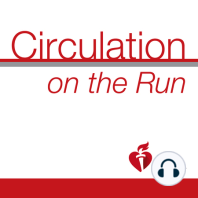18 min listen
Circulation June 2, 2020 Issue
ratings:
Length:
25 minutes
Released:
Jun 1, 2020
Format:
Podcast episode
Description
In today’s episode, Dr Carolyn Lam discusses the prevalence of familial hypercholesterolemia among the general population and patients with atherosclerotic cardiovascular disease with Dr Kausik Ray (KOSH) and Dr Amit Khera. Dr Carolyn Lam: Welcome to Circulation On the Run, your weekly podcast summary and backstage pass to the journal and its editors. I'm Carolyn Lam, associate editor from the National Heart Center and Duke National University of Singapore. Dr Greg Hundley: And I'm Greg. I'm the associate editor from the Pauley Heart Center at VCU health in Richmond, Virginia. Dr Carolyn Lam: Greg, ever wondered what's the prevalence of familial hypercholesterolemia in the general population? It's an important question, but we're going to wait to discuss that with our feature discussion coming right up. First, I want to tell you all about valvular heart disease. In a preclinical model, would you believe, but first let me just remind us all that primary valvular heart disease is a really prevalent cause of morbidity and mortality. And although the primary consequence of valvular heart disease is myocardial dysfunction, treatment of valvular heart disease has always centered around valve repair or replacement, rather than the prevention or reversal of myocardial dysfunction. In fact, have you thought about this? We know very little about the mechanisms, the actual preclinical underlying mechanisms of left ventricular dysfunction and primary severe mitral regurgitation. Well, in the first paper I want to talk about today, Dr Li from First Affiliated Hospital, Sun Yat-sen, University Guangzhou, and Dr Sadek, from UT Southwestern Medical Center and their colleagues develop the first mouse model of severe mitral regurgitation. And they did this by severing the mitral valve leaflets and chords using iridectomy scissors. Similar to the human condition, induction of mitral regurgitation was followed by gradual left ventricular dilatation and dysfunction resulting in severe systolic dysfunction. Further analysis revealed that severe mitral regurgitation resulted in a marked increase in cardiac mass, increased cardiomyocyte length, but not with, and electron microscopy evidence of sarcomere disarray and the development of sarcomere disruption. From a mechanistic standpoint, severe mitral regurgitation resulted in activation of multiple components of both the mTOR and Kelson urine pathways. Now intriguingly, inhibition of mTOR signaling even preserved sarcomeric structure and prevented left ventricular remodeling and systolic dysfunction. Finally, immunohistochemical analysis uncovered a differential pattern of expression of the cell polarity regulator CRB2, along the longitudinal axis of cardiomyocytes and close to the intercalated discs, with a similar pattern of polysome localization. And all of this suggests a potential new mechanism of longitudinal cardiomyocyte growth. Dr Greg Hundley: Well, Carolyn, there is a lot of basic science and a lot going on both histopathologically, but also mechanically with this model. What's our take home message? Dr Carolyn Lam: Well, Greg, this mitral regurgitation mouse models suggest that cardiomyocyte hypertrophy in response to mitral regurgitation is a maladaptive process that may be pharmacologically targeted by mTOR inhibitors. Dr Greg Hundley: Oh my, very nice Carolyn. Well, I'm going to bring you another kind of basic science paper as well. And it's from Dr Jin Li from the Institute of Biochemistry and Molecular Medicine at the University of Bern. And it really involves auto antibody signatures in cardiac arrests. So Carolyn, a quiz of what percentage of individuals sustaining out of hospital cardiac arrest have no known cause? Dr Carolyn Lam: You said, “Oh oh!” I’m on the spot here, Greg. Okay. What about if I start with what I do know? Coronary artery disease is the most common cause. I think that may be, I don't know, large majority, 80% of it. And then we get inherited cardiomyopathy, chan
Released:
Jun 1, 2020
Format:
Podcast episode
Titles in the series (100)
Circulation January 23, 2018 Issue by Circulation on the Run
